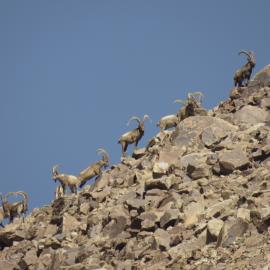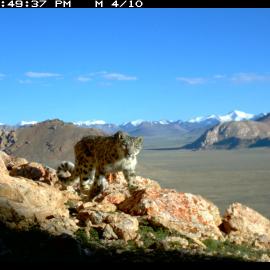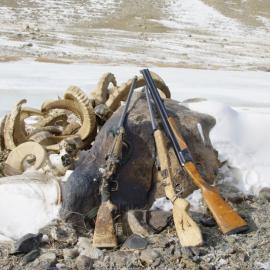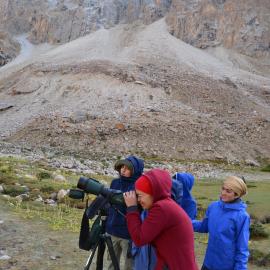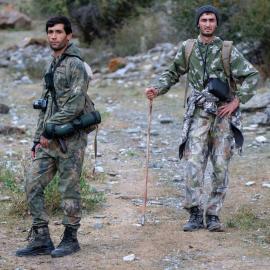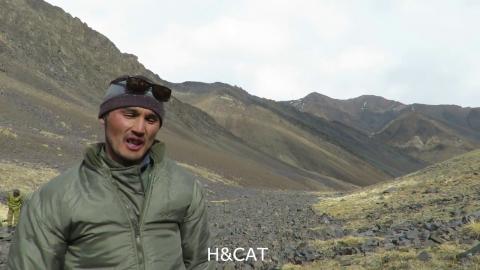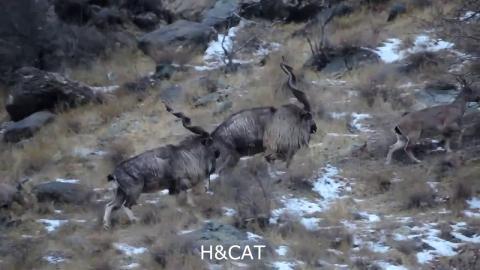Community-Based Wildlife Conservation in Tajikistan
Current initiative
Published
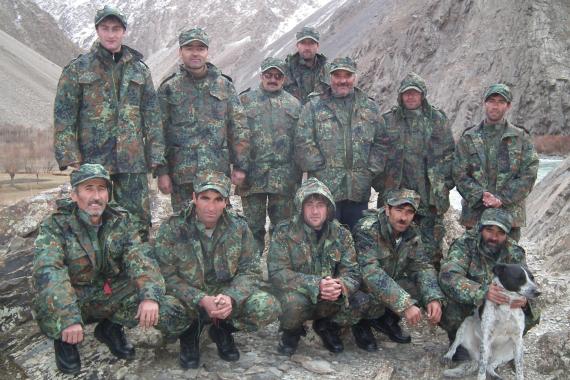
Local hunting guides and patrollers. Credit: Khalil Karimov
In the past, unregulated hunting and poaching of Tajikistan's wildlife not only threatened species such as the argali, Tajik markhor, urial sheep, Asiatic ibex, and snow leopard, it also compromised local peoples ability to draw sustenance from the land. Local people recognised that these wildlife declines would not only deprive them of their own hunting opportunities but would also cause the loss of related income opportunities and cultural heritage.
Since 2008, with the support of wildlife conservation and development organizations conservancies - land that is owned and managed by families or associations of local village hunters - have been established. Revenues generated from guided hiking, game-viewing, wildlife photography, and hunting support the work of local rangers and nature guides, and any surpluses are invested in local development projects. This approach provides revenues to local families and motivates them to refrain from unsustainable practices and protects wildlife populations and the habitat they rely on.
Lead
Location
The following Tajikistan conservancies are included in this initiative: Parcham, Yoquti Darshay, Yuz Palang, Burgut, Guldara, Obi Safed, Rohi Abreshim, Sarsarak, M-Sayod, Saidi Tagnob, Morkhur, Kuhistoni Mastchoh Travel, and M-Bukhori.
Tajikistan is a mountainous, landlocked country in Central Asia. It is a beautiful country with impressive landscapes and friendly people, famous for their hospitality. Mountains cover more than 90% of the country. The country’s mountain ecosystems are home to some of the most remarkable wildlife of Asia, like snow leopard, argali, Tajik markhor, urial sheep, and Asiatic ibex.
The poaching and wildlife trade problem
Species affected Argali Sheep Ovis ammon , Markhor Capra falconeri heptneri , Severtsov Argali Ovis ammon severtsovi , Siberian Ibex Capra sibirica , Snow Leopard Panthera uncia , Urial Ovis vignei
Products in tradeTrophies: for snow leopard (including full body and pelts), argali, ibex, markhor, urial
Body parts: for snow leopard (bones, fur, meat), for argali, ibex, markhor, urial (horns, meat)
Overview of the problem
The people living in the remote areas of Tajikistan live an almost subsistence existence, relying almost exclusively upon livestock for food and income generation. Food was supplemented by illegal and unsustainable subsistence hunting of ungulates, as well as for sport - which was exacerbated by the availability of guns.
In-depth interviews with the traditional hunters of remote valleys revealed that major motives for unsustainable hunting mainly has root in lack of alternative income-generating and employment opportunities which made irresponsible hunting bloom and in some remote places even become livelihood approach. Large-scale household expenditure, such as wedding and funeral ceremony was always supplemented with wild meat. This long-lasting unsustainable hunting impacted negatively upon numerous wild species and threatened their viability.
For the snow leopard, livestock provide a source of food, and increasingly so as populations of its natural prey – wild goats, argali and other wild sheep, and ibex – are being depleted as habitat is lost to livestock that overgrazes the vegetation (leaving little for these wild mountain ungulates), from unsustainable hunting for meat by locals, and illegal trophy hunting. This problem was exacerbated by prohibiting hunting to local people, which disenfranchised them and made their compliance with laws minimal.
When a snow leopard kills livestock the results can be catastrophic for the herders whose entire livelihoods depend on their herd, and farmers may retaliate by killing snow leopards. It has been estimated that up to half of all snow leopard deaths are a consequence of human-wildlife conflict.
Outsiders are also involved, including poachers of snow leopard, argali and ibex.
The anti-IWT initiative
Community-based wildlife management is a recent development in Tajikistan. In some areas, local traditional hunters increasingly realised that the declines of wildlife were a direct effect of unregulated and intensive hunting and that such declines would ultimately not only deprive them of their own hunting opportunities but also cause the loss of related income opportunities and cultural heritage.
Since 2008 wildlife management areas - or conservancies - that are protected by families or associations of local hunters have been established with the support of wildlife conservation and development organisations such as the Association of Nature Conservation Organizations of Tajikistan (ANCOT). Local ex-hunters help to prevent community members and outsiders from poaching. With wildlife numbers on the rise legal and regulated trophy hunting, and other revenue-generating activities such as guided hiking, game-viewing, wildlife photography, was introduced.
Revenues generated from these enterprises support the work of local rangers and nature guides, and any surpluses are invested in local development projects. This approach provides revenues to local families and motivates them to refrain from poaching and to protect wildlife populations and the habitats they rely on.
ANCOT has the following goals:
- Promote the conservation and sustainable use of the different species found in the conservancies, including strictly regulated and sustainable hunting of Asiatic ibex, argali sheep, Bukhara urial, Tajik markhor, and wild boar, and nature tourism with protected species, like snow leopard, brown bear, and many other species, providing the attraction;
- Supporting the conservancies’ managers in the conservation and sustainable use of its wildlife, pastures, forests, mountains and other natural resources;
- Providing advice to the NGOs, small family businesses and local communities on governance and institutional issues, including advice on how best to invest proceeds from hunts in projects aimed at improving local livelihoods and fostering the development of the communities in and adjacent to the conservancies;
- Marketing the uniqueness of the hunts as well as other tourism opportunities, by highlighting the benefits to wildlife conservation, livelihoods of rural people and the sustainable development of the involved communities; and
- Acting as the link between the community-based organisations, managing the conservancies and offering hunting and tourism services, and the interested hunters, hunting outfitters, tourists, and travel companies.
ANCOT and its partners address the conservation of the entire ecosystem and its biodiversity, including carnivores like the snow leopard, and the development of the local community in a way that is sustainable and does not harm their environment and wildlife. The initiative specifically seeks to address the motivation for communities’ involvement with poaching and the IWT. The central tenet of the project is that without community support and engagement, the poaching problem will not be resolved. Sustainable and well-regulated hunting is an important part of the conservation approach of ANCOT and its members. Sports hunting by international hunters can provide the necessary financial means to fund wildlife conservation in the conservancy areas and motivate local communities through investments in community development. The hunting offers marketed by ANCOT on behalf of its members are in accordance with the principles of conservation hunting, in particular through quota setting and selection of animals for harvest in a way that minimises the impact on population numbers, demographic structure, and genetics.
Inclusion of gender, age and ethnic groups
The initiative involves entire villages and also some specific members, including ex-poachers and women.
The strategy
Strengthening disincentives for illegal behaviour
- 60% of proceeds from hunts go to anti-poaching and rangers salaries. (nb. rangers increasingly include ex-poachers).
- Although incidental, there are performance-based payments in the form of tips from satisfied tourists and hunters.
- Community rangers work on a voluntary basis until revenue from hunting and/or other tourism is generated.
- In-kind support comes from NGOs or donation from companies (e.g. uniforms from PATAGONIA, SITKA Gear, Swarovski).
- By the nature of our close work with communities, we make sure they are informed regarding wildlife crime penalties.
- Other strategies to strengthen disincentives include providing the rangers and guides with training, e.g. camera-trapping techniques, scat surveys, GPS techniques, ungulate age-class identification, and information relay protocols.
Increasing incentives for wildlife stewardship
- Sustainably-managed ungulate hunting (low-volume/high-value) generates local employment and revenue (3,600 USD per ibex and 32,500 USD for the argali). The net income by all ANCOT members is around 500K/year. Individual income depends on the value of the species.
- Ecotourism is proving to be a good way to keep rangers busy during the non-hunting season whilst also patrolling areas. Tourism is not an alternative to the sustainable use of wild meat and trophies, but a good addition. Net income from this activity is around 10K/1year.
Decreasing the costs of living with wildlife
Support from NGO Panthera: Building of predator-proof (snow leopard) livestock corrals to eliminate household food insecurity and economic vulnerability from carnivore attacks on livestock (one sheep is worth around £64 = 5 months of cash income).
This eliminates the incentive for retaliatory killings and reduces snow leopard availability for IWT
12 communal corrals have been built that protects about 8,000 sheep/goats and 16 households from 10 villages.
Villages waiting for corral construction have been provided with 20 fox-lights (solar-powered, light sensor devices that produce light at random intervals to emulate a moving person carrying a flashlight/torch) which deters leopards and other wildlife.
Increasing livelihoods that are not related to wildlife
50% of proceeds from hunts are invested in developing and maintaining micro-finance programs, healthcare facilities, schools (e.g. purchase of books), water infrastructure, provision of flour & coal, construction of 3 homes for homeless families and conservation activities.
Has the initiative made a difference?
Poaching and IWT have decreased and communities are benefiting from the implementation of the initiative. As a consequence, populations of wildlife have recovered (or are recovering), and the livelihoods of local communities have improved.
Today, community-based conservancies cover almost 300,000 ha of wildlife habitat, which is protected by community rangers, inhabited by healthy and growing populations of mountain ungulates and other wildlife, and provides excellent opportunities for observation of animals and for responsible and sustainable hunting tourism. In summary, some of the positive outcomes include:
- Around 300 jobs in Tajikistan have been created.
- Around 20,000 people benefit indirectly.
- Around 2500 ibex, 1500 argali, 2000 markhor, and 70 snow leopards are protected.
- Traditional poachers now have effective economic incentives not to poach, have changed their 'poaching mentality' and are now genuine protectors of wildlife. Trophy hunting of wild ungulates and nature tourism generally has proven to be a powerful incentive for local communities to conserve the snow leopard and their prey.
Project is sustainable and not dependent on external support.
Factors for success
Supportive national policy/legislation on sustainable use of natural resources
Sufficient time investment in building relationships and trust between the initiative and local communities
Clear and tangible benefits to local communities from wildlife (These may be financial and/or non-financial)
The Committee on Environmental Protection under the Government of the Republic of Tajikistan (CEPRT) ensures hunting permits are issued correctly and that conservancy hunting grounds are assigned at the appropriate level.
We have been working in Tajikistan since 2008 - fostering in-depth, lasting relationships based on trust and transparency with local communities is the reason we are able to do the work that we do.
Communities have clear and tangible benefits - including financial and non-financial gains.
Factors that limited or hindered success
Lack of long-term donor support that is flexible, adaptive and/or based on realistic time goals
Lack of supportive, multi-stakeholder partnerships with a shared vision
Lack of clearly defined tenure or resource use rights
To develop sustainable CBWM need sometimes up to 15 years; it is very difficult to secure long-term support with these time frames.
Most multi-stakeholders not interested in developing a true CBWM, only papers and powerpoints, but to persist through all the challenges does not interest them much, especially international NGOs.
Lack of clearly defined tenure of resource rights refers to elite-capture (this is outsiders, non-community groups).
Organisers, donors and partners
Implementing organisations: Community-Based Wildlife Conservancies of Tajikistan
Partners and donors.
Deutsche Gesellschaft für Internationale Zusammenarbeit (GIZ)
IWT Challenge fund
UK Government Trust for Mutual Understanding
Judith McBean Foundation
National Geographic
Big Cats Initiative
The Global Alliance for Wild Cats
Panthera
Committee on Environmental Protection under the Government of the Republic of Tajikistan.
Wildsheepfoundation
Safari Club International
Foundation Working Dogs For Conservation (WD4C)
CITES Secretariat, EcoEnforce
CIC - International Council for Game and Wildlife Conservation Dallas Safari Club,
Zoologische Gesellschaft für Arten- und Populationsschutz (ZGAP)
NABU (Nature and Biodiversity Conservation Union)
The Darwin Initiative
Sitka gear
Patagonia clothing.
For further information contact Association of Nature Conservation Organizations of Tajikistan (ANCOT) (info@tajwildlife.com).
